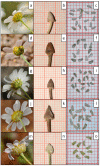A Morphometric and Karyological Study of the Anthemis macedonica Group (Asteraceae, Anthemideae) Reveals a New Species from Greece
- PMID: 36365459
- PMCID: PMC9656085
- DOI: 10.3390/plants11213006
A Morphometric and Karyological Study of the Anthemis macedonica Group (Asteraceae, Anthemideae) Reveals a New Species from Greece
Abstract
A recent study of the Anthemis collections in the Balkans indicated that the taxa of the Anthemis macedonica group (A. macedonica subsp. macedonica, A. macedonica subsp. thracica, A. meteorica, A. orbelica) exhibit noteworthy morphological patterns not evaluated before. We applied morphometric approaches (principal components analysis, PCA; factor analysis on mixed data, FAMD) by considering 19 qualitative and 20 quantitative morphological characters, together with three ratios, in 26 populations of this group. Furthermore, the chromosome numbers and karyotype morphology were investigated in eight populations of the group, covering the taxa participating in the study. Our results revealed that the southernmost populations of the group represent a hitherto unknown species confined to serpentine: it is described here as Anthemis serpentinica Goula & Constantinidis. The morphological evidence supports the proximity of A. macedonica and A. orbelica, which would be better considered as subspecific entities of the same species. On the contrary, A. meteorica and A. thracica are retained as independent entities at species level. All taxa share the same diploid chromosome number of 2n = 2x = 18 with similar but not identical karyotypes. A brief description of all taxa, based on recent new collections, and a dichotomous key are presented. Lectotypes are designated for Anthemis macedonica and A. meteorica.
Keywords: Anthemis; Asteraceae; karyology; morphometry; new species; systematics; ultramafic substrates.
Conflict of interest statement
The authors declare no conflict of interest. The funders had no role in the design of the study; in the collection, analyses, or interpretation of data; in the writing of the manuscript; or in the decision to publish the results.
Figures












References
-
- Oberprieler C., Himmelreich S., Källersjö M., Vallès J., Watson L.E., Vogt R. Anthemideae. In: Funk V.A., Susanna A., Stuessy T.F., Bayer R.J., editors. Systematics, Evolution, and Biogeography of Compositae. IAPT; Vienna, Austria: 2009. pp. 631–666.
-
- Lo Presti R.M., Oppolzer S., Oberprieler C. A molecular phylogeny and a revised classification of the Mediterranean genus Anthemis s.l. (Compositae, Anthemideae) based on three molecular markers and micromorphological characters. Taxon. 2010;59:1441–1456. doi: 10.1002/tax.595010. - DOI
-
- Oberprieler C. Phylogenetic relationships in Anthemis L. (Compositae, Anthemideae) based on nrDNA ITS sequence variation. Taxon. 2001;50:745–762. doi: 10.2307/1223705. - DOI
-
- Oberprieler C. Temporal and spatial diversification of Circum-Mediterranean Compositae-Anthemideae. Taxon. 2005;54:951–966. doi: 10.2307/25065480. - DOI
-
- Oberprieler C. The Systematics of Anthemis L. (Compositae, Anthemideae) in W and C North Africa. Bocconea. 1998;9:1–328.
LinkOut - more resources
Full Text Sources

